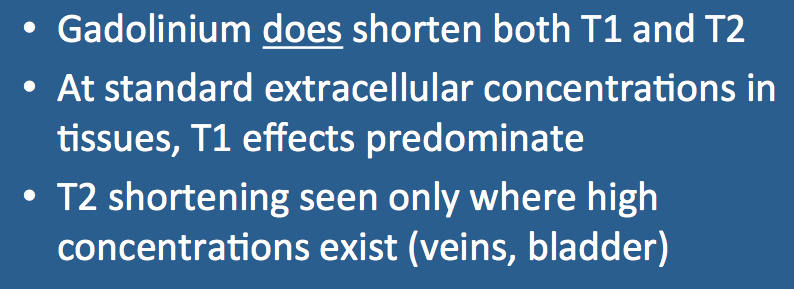In relaxation chemistry it is often more convenient to talk about relaxation rates rather than relaxation times. Relaxation rates, measured in sec−1, are simply the inverses of the relaxation times. Total relaxation rates of chemical processes are often the sum of relaxation rates of various component steps.
where r1 and r2 are called the specific relaxivities of the paramagnetic agent, measured in units of L/mmol-s. Although this formulation is strictly true only for contrast agents dissolved in pure solvents and lacking solute-solute interactions, clinical measurements have demonstrated that it is nevertheless a reasonable approximation for the relaxation effects of most extracellular gadolinium-containing contrast media in a variety of human tissues and tumors.
1/T1obs = (1/0.8) + (4)(0.1) = 1.65 sec−1, and
1/T2obs = (1/0.08) + (5)(0.1) = 13.0 sec−1
Advanced Discussion (show/hide)»
The simple treatment of relaxivity provided here is referred to as the "fast exchange" model which assumes all protons that contribute to the MR signal have equal and unrestricted access to the paramagnetic center on a time scale less than or equal to the T1 relaxation time of the medium. Clearly this is not the case with biological tissues where multiple compartments exist with different exchange rates that may even be different in the forward and reverse directions. Nevertheless, the simple treatment here goes a long way to explaining basic phenomena involving contrast agent behavior in tissues and solutions.
Elster AD. How much contrast is enough? Dependence of enhancement on field strength and MR pulse sequence. Eur Radiol 1997; 7:S276-S280.
Rohrer M, Bauer H, Mintorovitch J et al. Comparison of magnetic properties of MRI contrast media solutions a different magnetic field strengths. Invest Radiol 2005; 40:715-724.
What is the difference between relaxation rates and relaxation times?
Can the T2-shortening effects of gadolinium ever be observed on routine MR imaging?
What is meant by the relaxivity of a contrast agent? How is it measured?
